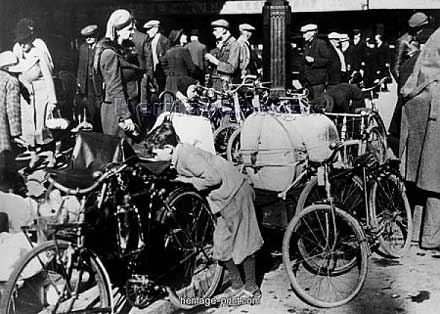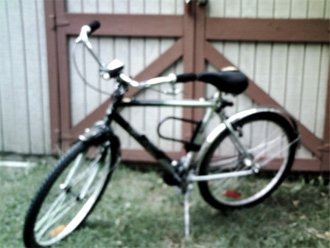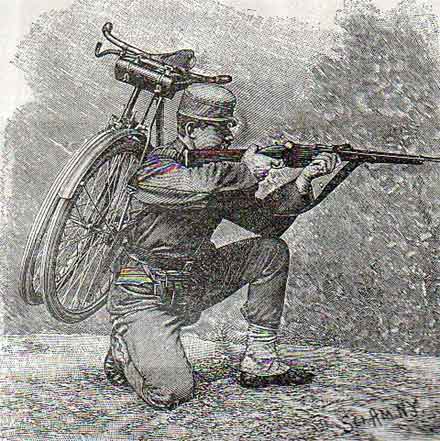
*Bicycles Revisited - and Rejected*
By: gvi
28 September 2011

"If you bug out without a destination, you are a refugee. If you don't have a way to get you there quickly and safely, you are a helpless refugee."
(Adaptation of Rubicon maxim)
[Author's Note: In a previous article the author describes his attempts at modifying a VERY humble bicycle so as to carry his service rifle while he rides. The reader may thus get the impression that he considers bicycles – and particularly, bicycles adapted to carry gear and weapons – to be a worthwhile option as Bug-Out Vehicles. However natural this supposition may be, the author wishes to point out that said article was written while he was in a unique position vis-à-vis riding around in public with a rifle – he was on a very large military base in northern Iraq.
This new article is inspired, not by those previous adventures "downrange", but by current experience stateside. It is a rebuttal of the conventional wisdom many survivalist writers preach and parrot; namely, that a bicycle is "better than going on foot and often an advantage" during a catastrophe.]
I've been trying as much as possible to get a lot of use out of my "new" bicycle. Doing so gives a fellow plenty of time to think. It gives a Rubie such as myself time to think about the way a person typically rides his bike, and of bicycles as BOVs or post-SHTF vehicles in a larger sense.
I'm quite proud of my bike - it is set up the way I want it set up, rides better and with less effort than previous bikes, and (with a nod to vanity) looks good...

Over the last few years we've seen many more adults on bicycles than previously, and the reasons are obvious. A quick glance can always tell you when a cyclist is using his machine for fitness or competition. In addition to the athletes in their sleek, brightly-colored livery and mushroom-top helmets, we also see many folks using their bikes as an option for greater thrift, something I always applaud. Some riders like the fact that they're better for the environment than autos. I'm all for being a good steward so long as said steward isn't a sanctimonious jerk about it.
Unhappily, we also see – in My Fair City anyway – many whom misfortune has overtaken, and for whom the bicycle is the only option for transport quicker than their feet. A middle-aged man with threadbare clothes, a five-day beard and a cheap one-speed Wal-Mart cruiser is not putting his bicycle to the same uses as the fellow in spandex on a racer. Both tend to be skinny but not for the same reason.
I don't wish to look like either - I use my bicycle for fitness as well as saving gasoline in town. I therefore have my bike set up after the fashion of a "European City Roadster" and dress as respectably as my lawful occasions require. Sure it's vanity, but it's of an innocent variety and the greater sin is pretending it doesn't exist.
But I digress.
Bicycles as BOV's
We turn our attention now to the thesis, this being a rebuttal of the idea that a survivalist ought to give serious consideration to bicycles as Bug-Out Vehicles or, at least, give them secondary consideration as a "better than walking" alternative. I submit that if you cannot drive, walking is FAR safer than riding a bicycle, particularly if alone or in a small group; say, under a dozen.
Riding a bicycle is an activity restricted to polite and civilized society – a society still governed by the spirit of orderly liberty and a modicum of respect for others. It is not, I submit, a worthwhile option for escape of a city in riot, or during an evacuation following a catastrophe, or after a disaster before rule-of-law is re-established.
In short, the bicycle is not an option where others have no reason to respect the cyclist, and plenty of reasons not to respect him. The bicycle is a hazard to its rider in a lawless environment.
Do this simple experiment the next time you have a chance. Go to the place in your community where you are likeliest to find a bicyclist. Position yourself in any place on the sidewalk and watch one go by. Imagine you are a ruffian looter, determined to relieve hapless victims of anything that might be of value. As the cyclist goes by, imagine running out and clothes-lining the cyclist, knocking him off his bike. You will see after a few cyclists go by that it would be simplicity itself, even without the least pretense of a weapon.
A cyclist is very vulnerable - he cannot accelerate quickly enough to avoid you, and unless he is a trick-rider and aware of the threat, he cannot maneuver out of your way. And if he is not suitably armed – in the rider's case a blunt weapon such as the sjambok (a flexible and extremely painful baton made notorious by white South African police) or a truncheon is far handier than a pistol or longarm – he is essentially defenseless unless travelling in a pack.
In rural areas the situation for the lone cyclist or small group is no better. Unless you're fit enough to do true off-road biking with a pack – and doing it now – you will find yourself either walking the bike or sticking to roadways, if you don't abandon your machine altogether.
It is as easy to shoot a cyclist as it is to shoot a walking or running man; easier, in fact, as it is more difficult for the cyclist to dodge and duck and he is of necessity more exposed.
The Road Less Traveled
Talk has been made of using abandoned railroad rights-of-way. These rights-of-way fall into two categories: railways that have been turned into a trail by a conservancy, and those that have not. Of the former, these are well-known and, in one case with which I'm familiar, high-crime areas against cyclists already – the Monon Trail in Indianapolis is at this moment a dangerous place for the cyclist, even in the daytime, despite the recent lifting of a prohibition on carrying sidearms on said trail.
As to the latter, the abandoned railroad that has not been improved except to take up the track, it is in no way "bike-friendly". Railroad ballast in my area consists of rocks about 2-4" in size. It was originally meant to distribute the weight of railroad cars without settling – it was never meant to accommodate foot or bicycle traffic and in fact does a fair job of discouraging it. The rocks are jagged, none too stable, difficult to walk on, and nearly impossible to ride over. Those with track still on them are no easier.
Besides, roadbeds for railroads are usually cleared for miles in any direction and often raised somewhat above the surrounding countryside (think of the "fatal funnel" in your home – now think of it with a clear line-of-sight for approximately two miles). There are few places for cover and at all events, the bicycle must be abandoned to reach that cover. And once you reach it, you're likely to wish you hadn't. In my area, the right-of-way of a railroad is usually fenced and always overgrown with poison ivy, "stickle-burrs", or a nasty species of thorny purple vine that I believe the railroads imported from hell for the purpose of discouraging trespassing (they work like a charm). Rubies have no business on a railroad right-of-way.
Lastly, look at the places through which a railroad right-of-way, whether active or abandoned, would take you. Exceptions aside, they generally run through industrial sites (teeming with vagrants) or down-at-the-heel neighborhoods (teeming with ruffians). Ask yourself if you really want to travel through these sorts of places on a vehicle which will leave you exposed, unable to maneuver or present a weapon quickly, and which will be difficult or impossible to negotiate on the uneven, jagged surface.
Those Plucky Vietnamese
In discussions of bicycles as transport or as beasts-of-burden, survivalist writers ALWAYS make mention of the Vietnamese along the Ho Chi Minh Trail. Historically savvy writers may also bring up the German Volksgrenadiers of WWII, who had whole battalions mounted on bicycles, or of the Japanese in Southeast Asia, or of European troops in WWI, or the hardy Swiss or any number of other military cycle formations throughout history.

The folding bike is on his back (poor fellow) and not levitating as it at first appears...
It is quite true that the bicycle was a force-multiplier for all these units and more. But the comparison between the military use and that of the survivalist is fatally misguided. While the bicycle has been successfully used in war, it does not follow that it is a worthwhile mode of transport for the survivalist. This is because:
They were used in large numbers - the only lone cyclists were couriers behind lines.
When they were used by infantry, their opponents were typically dismounted; the advantage lay in the fact that cyclists were able to move more quickly than a unit who was marching. As such, bicycles were used much like the horse for Dragoons of the 19th Century. They would ride for the approach march and deposit their bikes somewhere safely behind the Line of Departure/Line of Contact.
In the case of the plucky Vietnamese, the bicycle was the only option they had available in terms of carrying capacity, the terrain and numbers. When they had trucks, usable roads and the situation was safe enough for them, they invariably used trucks.
Being war and NOT survival, a certain number of casualties was simply considered the cost of doing business. We have no such thing as an acceptable number of casualties.
Infantry cyclists were fit 20-year old men, not schlumpy 40-year old fossils such as myself, or slight 13-year old girls such as my daughter.
Conclusion
I love my bike. I love riding it. Once it was set up to my liking, it became virtually without cost to operate; it helps me stay fit, and I almost always get "rock star parking" when I go anywhere. I find it a highly civilized way to get around town, and being a "city-mouse" by rearing and disposition, I happen to like civilization.
I live in a medium-sized college town, where I can hardly go anywhere without running into someone I know. The bicycle permits me to socialize far more easily than if I were whizzing past in a car. I have the option of simply waving and greeting my friends and acquaintances or, if time is not of the essence, of dismounting and sharing the walk, as I did yesterday with a friend from church who was going to the library. Moreover, My Fair City has made an active effort to be amenable to bicycles. It's not Boston (which must be the most bicycle-friendly region in America, to judge by the number of cyclists), but it's still a pretty easy and safe place to get around by bike.
A bicycle in My Fair City is a fine thing to have. It adds to my enjoyment of my community; and one of the lessons I've learned over time has been never to pass up an opportunity to add joy to one's life.
But I no longer consider it a BOV.
gvi
www.alpharubicon.com
All materials at this site not otherwise credited are Copyright © 1996 - 2011 Trip Williams. All rights reserved. May be reproduced for personal use only. Use of any material contained herein is subject to stated terms or written permission.